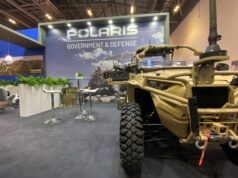The Royal Australian Navy and its international partners are returning to port after several weeks of successful exercises and wargames off the coast of Western Australia.
Leading the exercise the navy’s new Canberra class LHD HMAS Adelaide served as the flagship of a multinational fleet with the objective to move close enough to the Lancelin Naval Range to launch an amphibious assault. The exercise simulated an operation to support a beleaguered neighbour nation facing attack from the rouge state of Kamaria. Opposing them were a range of air and sea assets, including fighter jets and submarines, which put the task group through its paces against a range of simulated assaults.
Commodore Mal Wise, Commodore Warfare, said the exercise was “very challenging” for the task group and pitted two very equal sides against each other. HMAS Adelaide commanding officer Captain Jonathan Earley also highlighted the complexity of the fight but said ultimately it allowed the game changing nature and versatility of his new ship to show through.
Entering service in late 2014 the Canberra class vessels are the largest warships ever operated by the Royal Australian Navy and represented a significant leap in amphibious capability. Since then the Australian Defence Force has been working up its capability to deploy from these resources regionally and globally.
The exercise was also notable for the participation of warships from both Italy and Spain which are visiting Australia to demonstrate the capabilities of their classes. Derivatives of the Spanish Álvaro de Bazán class and the Franco-Italian FREMM class are both competing options for the Australian frigate replacement program. Both foreign vessels have made trips to key shipbuilding ports in Australia on their way to this exercise and in the process have entertained key industry figures and politicians as the tendering process commences.
The British Type 26 Frigate is considered one of the other leading contenders in the process, along with the Danish Iver Huitfeldt and the German MEKO 400.






The Iver Huitfeld and Meko 400 Class Frigates did not make it past the CEP process. The Italian FREMM, Navantia F100/ F105 derivative and T-26 are the three that went forward with one apparently being dropped quite recently but which one has not been publicly stated. Of the three, the FREMM and the Navantia derivative would have to be the front runners because the FREMM is already in service and the Hobart Class AWD is a derivative of the Navantia F100 hull, so is also a known quantity and the least risky of the three options. The T-26 is still a paper ship and the goal posts still keep moving on it, so it is still inherently very risky.